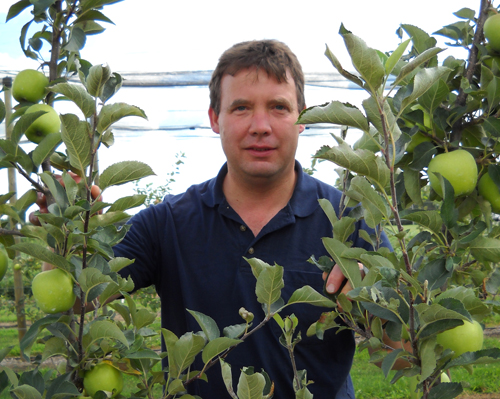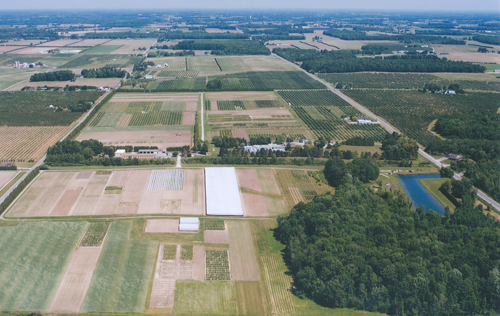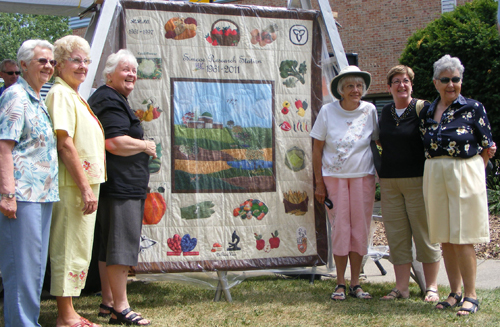
For your turkey, you’ll have to look elsewhere. But to fill your harvest table this weekend, you might find that many of your fruits and vegetables stem from the Simcoe Research Station. Apples, peaches, berries, tomatoes, asparagus, sweet corn, cabbages, potatoes: they are among various crops developed and studied for the past 50 years on the fertile Norfolk sand plain north of Lake Erie in Simcoe, Ont.
The station marked its half-century this summer, including the past 15 years under the umbrella of the Department of Plant Agriculture within U of G’s Ontario Agricultural College (OAC). Fifty years after the station opened, plant scientists and breeders are still raising those traditional crops on this 66-hectare block. And they’re also working on a few more exotic newcomers such as hazelnuts, ethno-cultural vegetables and Russian dandelion – and even various grasses intended not for your dinner plate but your gas tank.
Nothing sounds more traditional than Ontario apples. But some new twists are being developed at Simcoe for this staple orchard crop. Ask plant agriculture professor John Cline; tree fruits are his line, especially apples, peaches and cherries. For the past decade, he’s grown lots of Honeycrisp and Ambrosia apples, both prized for their firm, crisp and juicy fruit.
“The reason these are catching on is they have unique flavours and textures and they bring a high market price for growers,” he says. Indeed, these varieties can bring as much as four times more than conventional varieties like Macs and Empires.
Cline is interested in physiology and plant growth. He looks at substances that regulate the crop level, or the number of apples on the tree. “There’s a delicate balance between amount of shoot growth and fruiting. We’re trying to find the optimum.”
He also studies orchard systems. Don’t look here for a traditional apple orchard with rows of free-standing trees. Instead, what you see at Simcoe looks, at first, more like grapevines. “We grow apples more like grapes on high-density trellises,” says Cline.
That’s how many fruit growers produce apples today. Trellises allow growers to space their dwarf trees more densely, which helps in maintenance and harvesting and also yields desired fruit size and other traits. Cline says the trees develop fruit in about two or three years rather than five years in conventional orchards. He’s working with master’s student Kendra Sauerteig on tests of mechanical thinning, using a tractor-mounted device that removes flowers and is suited to trellis growing.
Three years ago, he started a project with Chudleigh’s Ltd. in Milton, Ont. That project looks at Northern Spy apples used by the company for its bakery. More people are buying Chudleigh products, he says, but fewer acres of traditional Spy apples are being grown as farmers switch to more lucrative crops or more easily grown cultivars. Now Cline is studying how to grow this challenging cultivar more efficiently.
Think peaches, and you might think of the Niagara Peninsula. But as competing land uses there drive up prices, Cline is looking at ideas for growing more peaches on all that Norfolk sand. As with apples, he’s using high-density planting for this tender fruit crop.
Besides improved labour efficiency and mechanization, that system makes watering easier. His plots use a trickle drip irrigation system under computer-controlled timing. “When you have a huge investment in dollars, you can’t take chances with low-quality fruit. You can’t control the weather but you can control drought.”

On a tour aboard a Gator utility vehicle, Cline points out these and other research plots around the station.
Simcoe researchers have studied weed control to provide information for regulators spelling out uses of pesticides for crop production. That work began with retired professor John O’Sullivan and now involves Prof. Rene Van Acker, OAC associate dean (external relations). “Farmers growing processing vegetables need options for weed control,” says Van Acker. “The program at Simcoe gives data for pesticide registration to allow for those options legally. That’s especially important for new crops. Simcoe is one of the places doing a lot of that work.”
Researchers here are also looking at growing crops for biomass production for use as alternative fuels. Led by Prof. Bill Deen in plant agriculture, this project looks at production requirements, including yields and responses to fertilizers. The project is in its third year.
“We know generally that we can grow these crops in a variety of settings in Ontario,” says Van Acker. Guelph scientists have also studied overwintering in miscanthus and switchgrass, crops normally grown in prairie settings. “This is valuable information for growers. Growers are going to invest in a long-term stand; they want to know which biotypes and areas overwinter well.”
Elsewhere on the station are plots of berries and nuts. Plant agriculture professor Adam Dale arrived at Simcoe in 1983 to study berry crops. Today he’s still working with strawberries and raspberries. Initially he studied how to grow raspberries in greenhouses, including how to meet the plants’ needs for bumblebee pollination. Now he’s testing fruit growth in plastic field tunnels, a new method for Ontario. In other countries, he says, the technique has tripled yields for fall-bearing varieties.
Dale has also resumed a breeding program to develop fall-bearing cultivars for the greenhouse trade. Earlier, a variety called Autumn Britten developed in the United Kingdom had undergone field trials at Simcoe. “That variety has become the major fall-bearing raspberry in Ontario. It was the variety that made Ontario growers realize you can grow fall-bearing raspberries.”
Strawberry breeding also continues at Simcoe. Dale studies day-neutral strawberries that fruit not just in June but all season long. He’s also developing glyphosate-resistant plants intended to help farmers battle weeds.
Strawberries are normally propagated from runners, or shoots growing from the plant roots. Looking for a better way to supply Ontario growers, he has looked at how to grow the plants from seed, as in corn. That will make them easier to propagate and plant, and yield faster-growing fruit. Dale has been working on soft-fruit genetics with collaborators in Florida and Portugal.
More recently, he has worked with other U of G faculty and researchers at the Vineland Research and Innovation Centre in Vineland, Ont., on a project to develop a homegrown hazelnut industry. They planted several acres of seedlings in Simcoe and Vineland three years ago; they’re picking the first crop this year. Ultimately, they hope to help provincial growers create a homegrown industry to supply various markets, including fresh market and confectionery makers.
Dale is also testing blight-resistant American chestnut trees, hoping to restore a native variety practically wiped out by blight 20 years ago. “Before that, the American chestnut was the dominant tree in the Carolinian forest throughout North America,” says Dale. The work involves crossing scattered survivors in southern Ontario with resistant hybrids from the United States.
Pick up asparagus at your grocery store, and there’s a good chance you’ve found “Guelph Millennium.” The popular variety developed in 1996 accounts for most of the seed sold in Ontario, says breeder and plant agriculture professor David Wolyn. Seed is also sold to several American states and European countries.
The crop gives farmers sustained high yields, an improvement over earlier asparagus varieties that faded after a few years. “That’s money in the grower’s pocket,” says Wolyn.
He had begun working with the crop in the former Cambridge research station. After Cambridge closed in 2003, he shifted the program to Simcoe, which he calls “the heart of asparagus growing” in Ontario. Wolyn continues to look for better disease resistance and better quality asparagus, even under hot weather conditions.
This summer, he also tended an unusual crop: Russian dandelion. He’s grown about 2,000 plants at Simcoe acquired from Kazakhstan. This fall, Wolyn will harvest and begin assessing dandelion roots for natural rubber content. He’s looking for breeding candidates to help develop a potential homegrown replacement crop for the natural substance obtained from rubber trees in Southeast Asia.
Russian dandelion might sound unlikely, but Simcoe researchers are also looking at new kinds of vegetables, including so-called ethno-cultural vegetables now in greater demand in Ontario and across Canada. Test plot trials at Simcoe were used for a study published this fall by OAC researchers. That paper looked at vegetables in high demand among Canadians of Afro-Caribbean descent and barriers to Ontario production of that produce, notably okra, African eggplant and amaranth.
That work builds on three decades of Simcoe research in physiology and management of numerous crops by plant agriculture professor Alan McKeown. The two-time Guelph graduate helped improve seed potato production in Ontario and has developed grower recommendations for plant nutrition. Recently, he has looked at plant nitrogen requirements, including recommending slow-release fertilizers that are more environmentally friendly. He has also studied Asian vegetables, helping provide nutrient information for growers.
“With changes in the country’s population mix from various origins, it’s a varied and wide market,” says McKeown, who will retire in spring 2012. He says growing information is vital in encouraging growers to supply that market, never mind encouraging retailers to stock products. “It’s always difficult trying to get these things into the food distribution system. There is a market there, but getting into the mainstream takes time.”
Other new crops for Simcoe include sweet potato; earlier studies occurred at the station until the early 1970s. McKeown has been working with American collaborators to evaluate cultivars and their nitrogen nutrition. He has also worked with lavender growers to help establish a new industry for local farmers; this year saw the inaugural lavender festival held in Simcoe. Growers are interested in growing the flower – suited to the local sandy soil – for agro-tourism and for its therapeutic properties.

Asparagus, apples, nuts and berries, and various vegetables all appear on a commemorative quilt created by the Twilight Quilters Guild of Norfolk County to mark the station’s half-century. Completed this year, the piece now hangs in the building lobby.
Helping to run the quilt project was Dianne Bakker, whose family for years grew broccoli on a farm in Waterford, Ont., a 30-minute north of Lake Erie. Bakker says the station has long provided extension services to area farmers. Indeed, studies by Simcoe researchers routinely appear in industry publications, including recommendations in fact sheets published by the Ontario Ministry of Agriculture, Food and Rural Affairs (OMAFRA). Ministry extension workers are also located at the station.
If Bakker wasn’t out helping to harvest the family’s crop for market, she was in the field helping her daughter, Cathy, who studied broccoli nutrition at U of G for her master’s degree. Now a technician working at the station with McKeown, Cathy had completed a Guelph undergrad in agriculture in 1997.
That was the year that various stations and other research facilities – including the campuses in Ridgetown, Kemptville and Alfred – were transferred to U of G under a partnership with OMAFRA. That agreement was renewed in 2008 for another 10 years.
The Simcoe station opened in 1961 after Norfolk County growers called for a horticultural research station in the area. It was initially run by the Horticultural Research Institute of Ontario.
More information about Simcoe research appears in a commemorative book published this year called Celebrating the Past, Growing the Future.
Writing in that publication, Prof. Peter Pauls, chair of plant agriculture, said: “The research station serves an important role in maintaining vibrant rural communities in Norfolk, Brant, Elgin, Oxford and Middlesex counties through innovation in vegetable and fruit crops and production practices for farms throughout this region. The research that has been done and will be conducted at the Simcoe Research Station gives farmers valuable options that take advantage of the productive soils, favourable climate and unique market access found in south-central Ontario.”